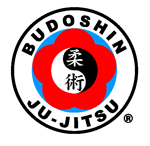 |
The Budoshin Ju-Jitsu Logo |
The Budoshin Ju-Jitsu logo [a registered trademark]
was designed with the philosophy of the art in mind rather than just the
physical aspects. "Budoshin" means to conduct oneself in an honorable &
respectable manner. The symbolism of the logo should help you along this
path. The information below is a summary of the symbolism of the
Budoshin Ju-Jitsu logo.
The four colors on the colored logo represent
traditional concepts: WHITE— purity & truth; BLACK— death; RED— life;
BLUE— serenity & peace.
The first design [red] symbolizes the five spiral
steps of learning: patience, repetition, understanding, experimentation,
& evaluation. These five steps form a continuous spiral as the last step
leads back to the first while, at the same time not returning to the
point of origin because what has been gained from the learning process
expands the base from which to learn more. Think of a "slinky" toy if
you want to visualize this concept. It also incidentally symbolizes the
lotus blossom. The lotus blossom symbolizes the
inseparability of cause and effect, the provision and reality, and the
source and manifestation of enlightenment. It helps bring the
interrelationships of the Yin-Yang together.
If you wish to be more esoteric it could be said
that the five petals of the lotus blossom also represent the five basic
elements of gojo-goyoku: earth [chi], air/wind [fu], fire [la], water
[sui] and void [ku]. This brings us back full circle [pardon the pun] to
the five steps of learning and the circle in the center.
The second design, located in the center, is the
Yin-Yang or Tao [Chinese], which represents the duality or
interrelationships of good-evil, light-dark, mind-body, male-female,
etc.-etc. Within the framework of Ju-Jitsu techniques this symbol also
illustrates the circular flow of ki & motion, as well as the flowing
nature of the art. This symbol is located in the center of the above
spiral & is the center circle created by the spiral.
If you look at the design carefully you will notice
a 6th circle created by the spiral for the obvious Yin-Yang symbol. But
at a higher level it indicates the concept of the "sixth sense" that
martial artists develop — which some call "mushin".
One could write a book about all of the
philosophical relationships mentioned, but that's not my purpose here.
It is only to help you understand the interrelationship of ideas and how
one thing affects another; the infinity of the yin-yang.
The background color of blue, behind the spiral, is
to indicate the sky which is indicative of peace and serenity.
You will also notice that there are three rings -
or circles in the design - that indicate key elements of the personal
philosophy of Budoshin Ju-Jitsu: humility [represented by the outer
circle - or circular shape - of the patch], respect [represented by the
middle circular border between the white & blue backgrounds], and
integrity [the inner circle within which lies the yin-yang]. The
relationship of these three circles also establishes and represents the
essential relationship between integrity, respect, and humility, a
necessary philosophical foundation for any sincere martial artist -- in
any art.
The term "Budoshin Ju-Jitsu" was first formally
copyrighted in 1973 by George Kirby as a title of the book, Budoshin
Ju-Jitsu: Instructor's Manual. "Budoshin Ju-Jitsu" officially became a
registered trademark name in 1995.
[Return
to top of page.]
|
